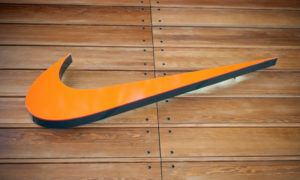Two decades ago, the world was introduced to an apparel company run by an upstart young businessman from a struggling American city. In starting Under Armour, Kevin Plank directly competed with one of the most iconic brands the world has ever known and saw an opportunity to go toe to toe with a brand he believed had gotten stale, boring and safe.

With an edge that befit the XFL (remember that?!?!) more than the NFL, Under Armour’s avant-garde marketing helped it grow into one of the most successful challenger brands in recent memory, and it looked like it was playing a different marketing game than the icon it was in the midst of dethroning. When Nike zigged, Under Armour zagged. While Nike chose to grow steadily with its cadre of safe superstars like Michael Jordan and Roger Federer, Under Armour signed new, up-and-coming talent it could brand, like Steph Curry and Jordan Speith. But this week Nike followed in the unorthodox footsteps of its rival when it unveiled the face of the 30th anniversary “Just Do It” campaign, Colin Kaepernick.
By now, you’ve surely seen the political hot takes, and likely have an opinion one way or the other about the decision to use Kaepernick. This isn’t about that. Instead, we want to look at the factors that fueled Nike to choose this moment in time to make its gutsiest marketing decision to date. To understand what drove the decision, one must look no further than the brand’s own words.
“Just Do It”
For the life of the “Just Do It” campaign, that’s exactly what Nike did. It just did it, plodding along with relatively cool athletes doing relatively cool things year after year, but rarely putting out ads that rocked the landscape. In recent years, Nike has started to take greater risks in its marketing, but this week, Nike went all in. Consider these circumstances:
- Nike is the apparel partner for the NFL and responsible for outfitting all 32 teams.
- Kaepernick is involved in a lawsuit where he is alleging collusion among the NFL owners.
- President Trump has successfully used Kaepernick’s decision to kneel during the National Anthem to create a national controversy, fueled mostly on social media.
- The NFL kicks off tonight.
Clearly, the forces that are driving today’s marketplace convinced Nike executives that now was the right time to make this bold move. “The Cone 2018 Purpose Study” showed that 78% of consumers today believe that a brand should be about more than making money, and that it should make a difference. Consumers today are demanding that companies put a line in the sand and show where they stand on controversial issues. In exploring how companies are navigating today’s challenging marketing times, our colleagues Abbey Ahearn and Alexandra Compare recently recommended that brands understand where they have permission to play. These two factors likely combined to drive Nike’s decision.
To discount how Nike accelerated the re-writing of the marketing rules would be naive. Nike is using a hot-button issue to fuel a campaign that is overwhelmingly full of messaging that is generally inspiring in nature. Driving individual motivation is the message Nike is imparting in this campaign, with rhetoric like “Don’t believe you have to be like anybody to be somebody” and “Don’t ask if your dreams are crazy. Ask if they’re crazy enough.” Who can argue with that?
“Believe in something even if it costs you everything.”
The tagline of the new campaign asserts that believing in something has cost Kaepernick everything. Whether or not you agree with that statement the symbolism and symmetry between Nike and its new poster boy is unavoidable. Believing in Kaepernick may cost Nike everything but Nike has decided that it is more important in this moment to be on record taking a position (even one half the country disagrees with) than sitting on the sidelines.
Skeptics will argue that this is a business decision by Nike, who looked at a customer base that is increasingly young and urban, ran some Focus Groups and decided that its target largely agreed with Kaepernick and that this wasn’t actually the risk it’s made out to be. Isn’t that the point, though? The ground has shifted so distinctly that the wise business decision is to insert your brand into a debate that will alienate half the country.
Can Nike successfully thread the needle of fueling a motivational campaign through echoes of dissent? Are the roots of one of Nike’s most important partnerships strong enough to withstand the turbulence that will certainly present itself? And, will showing the world that it believes in something cost Nike everything?
Initial market performance for Nike shows a bit of push back and Twitter is abuzz with dissenters burning Nike products. Surely, Nike knew this was coming. What’s more important is what comes next once the initial reaction has settled. Only time will tell if the risk Nike took with this ad was worth the reward.
